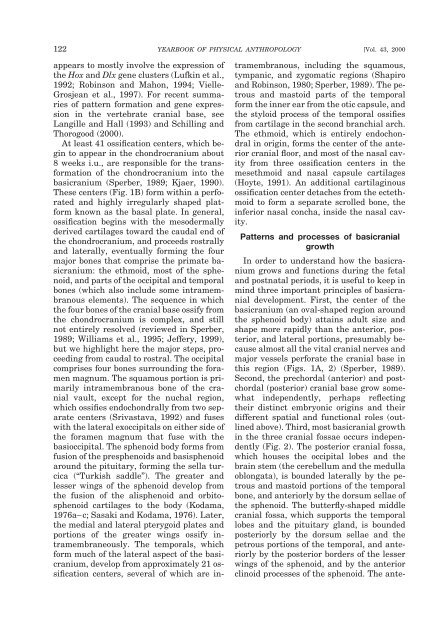The primate cranial base: ontogeny, function and - Harvard University
The primate cranial base: ontogeny, function and - Harvard University
The primate cranial base: ontogeny, function and - Harvard University
Create successful ePaper yourself
Turn your PDF publications into a flip-book with our unique Google optimized e-Paper software.
122 YEARBOOK OF PHYSICAL ANTHROPOLOGY [Vol. 43, 2000<br />
appears to mostly involve the expression of<br />
the Hox <strong>and</strong> Dlx gene clusters (Lufkin et al.,<br />
1992; Robinson <strong>and</strong> Mahon, 1994; Vielle-<br />
Grosjean et al., 1997). For recent summaries<br />
of pattern formation <strong>and</strong> gene expression<br />
in the vertebrate <strong>cranial</strong> <strong>base</strong>, see<br />
Langille <strong>and</strong> Hall (1993) <strong>and</strong> Schilling <strong>and</strong><br />
Thorogood (2000).<br />
At least 41 ossification centers, which begin<br />
to appear in the chondrocranium about<br />
8 weeks i.u., are responsible for the transformation<br />
of the chondrocranium into the<br />
basicranium (Sperber, 1989; Kjaer, 1990).<br />
<strong>The</strong>se centers (Fig. 1B) form within a perforated<br />
<strong>and</strong> highly irregularly shaped platform<br />
known as the basal plate. In general,<br />
ossification begins with the mesodermally<br />
derived cartilages toward the caudal end of<br />
the chondrocranium, <strong>and</strong> proceeds rostrally<br />
<strong>and</strong> laterally, eventually forming the four<br />
major bones that comprise the <strong>primate</strong> basicranium:<br />
the ethmoid, most of the sphenoid,<br />
<strong>and</strong> parts of the occipital <strong>and</strong> temporal<br />
bones (which also include some intramembranous<br />
elements). <strong>The</strong> sequence in which<br />
the four bones of the <strong>cranial</strong> <strong>base</strong> ossify from<br />
the chondrocranium is complex, <strong>and</strong> still<br />
not entirely resolved (reviewed in Sperber,<br />
1989; Williams et al., 1995; Jeffery, 1999),<br />
but we highlight here the major steps, proceeding<br />
from caudal to rostral. <strong>The</strong> occipital<br />
comprises four bones surrounding the foramen<br />
magnum. <strong>The</strong> squamous portion is primarily<br />
intramembranous bone of the <strong>cranial</strong><br />
vault, except for the nuchal region,<br />
which ossifies endochondrally from two separate<br />
centers (Srivastava, 1992) <strong>and</strong> fuses<br />
with the lateral exoccipitals on either side of<br />
the foramen magnum that fuse with the<br />
basioccipital. <strong>The</strong> sphenoid body forms from<br />
fusion of the presphenoids <strong>and</strong> basisphenoid<br />
around the pituitary, forming the sella turcica<br />
(“Turkish saddle”). <strong>The</strong> greater <strong>and</strong><br />
lesser wings of the sphenoid develop from<br />
the fusion of the alisphenoid <strong>and</strong> orbitosphenoid<br />
cartilages to the body (Kodama,<br />
1976a–c; Sasaki <strong>and</strong> Kodama, 1976). Later,<br />
the medial <strong>and</strong> lateral pterygoid plates <strong>and</strong><br />
portions of the greater wings ossify intramembraneously.<br />
<strong>The</strong> temporals, which<br />
form much of the lateral aspect of the basicranium,<br />
develop from approximately 21 ossification<br />
centers, several of which are intramembranous,<br />
including the squamous,<br />
tympanic, <strong>and</strong> zygomatic regions (Shapiro<br />
<strong>and</strong> Robinson, 1980; Sperber, 1989). <strong>The</strong> petrous<br />
<strong>and</strong> mastoid parts of the temporal<br />
form the inner ear from the otic capsule, <strong>and</strong><br />
the styloid process of the temporal ossifies<br />
from cartilage in the second branchial arch.<br />
<strong>The</strong> ethmoid, which is entirely endochondral<br />
in origin, forms the center of the anterior<br />
<strong>cranial</strong> floor, <strong>and</strong> most of the nasal cavity<br />
from three ossification centers in the<br />
mesethmoid <strong>and</strong> nasal capsule cartilages<br />
(Hoyte, 1991). An additional cartilaginous<br />
ossification center detaches from the ectethmoid<br />
to form a separate scrolled bone, the<br />
inferior nasal concha, inside the nasal cavity.<br />
Patterns <strong>and</strong> processes of basi<strong>cranial</strong><br />
growth<br />
In order to underst<strong>and</strong> how the basicranium<br />
grows <strong>and</strong> <strong>function</strong>s during the fetal<br />
<strong>and</strong> postnatal periods, it is useful to keep in<br />
mind three important principles of basi<strong>cranial</strong><br />
development. First, the center of the<br />
basicranium (an oval-shaped region around<br />
the sphenoid body) attains adult size <strong>and</strong><br />
shape more rapidly than the anterior, posterior,<br />
<strong>and</strong> lateral portions, presumably because<br />
almost all the vital <strong>cranial</strong> nerves <strong>and</strong><br />
major vessels perforate the <strong>cranial</strong> <strong>base</strong> in<br />
this region (Figs. 1A, 2) (Sperber, 1989).<br />
Second, the prechordal (anterior) <strong>and</strong> postchordal<br />
(posterior) <strong>cranial</strong> <strong>base</strong> grow somewhat<br />
independently, perhaps reflecting<br />
their distinct embryonic origins <strong>and</strong> their<br />
different spatial <strong>and</strong> <strong>function</strong>al roles (outlined<br />
above). Third, most basi<strong>cranial</strong> growth<br />
in the three <strong>cranial</strong> fossae occurs independently<br />
(Fig. 2). <strong>The</strong> posterior <strong>cranial</strong> fossa,<br />
which houses the occipital lobes <strong>and</strong> the<br />
brain stem (the cerebellum <strong>and</strong> the medulla<br />
oblongata), is bounded laterally by the petrous<br />
<strong>and</strong> mastoid portions of the temporal<br />
bone, <strong>and</strong> anteriorly by the dorsum sellae of<br />
the sphenoid. <strong>The</strong> butterfly-shaped middle<br />
<strong>cranial</strong> fossa, which supports the temporal<br />
lobes <strong>and</strong> the pituitary gl<strong>and</strong>, is bounded<br />
posteriorly by the dorsum sellae <strong>and</strong> the<br />
petrous portions of the temporal, <strong>and</strong> anteriorly<br />
by the posterior borders of the lesser<br />
wings of the sphenoid, <strong>and</strong> by the anterior<br />
clinoid processes of the sphenoid. <strong>The</strong> ante-
















